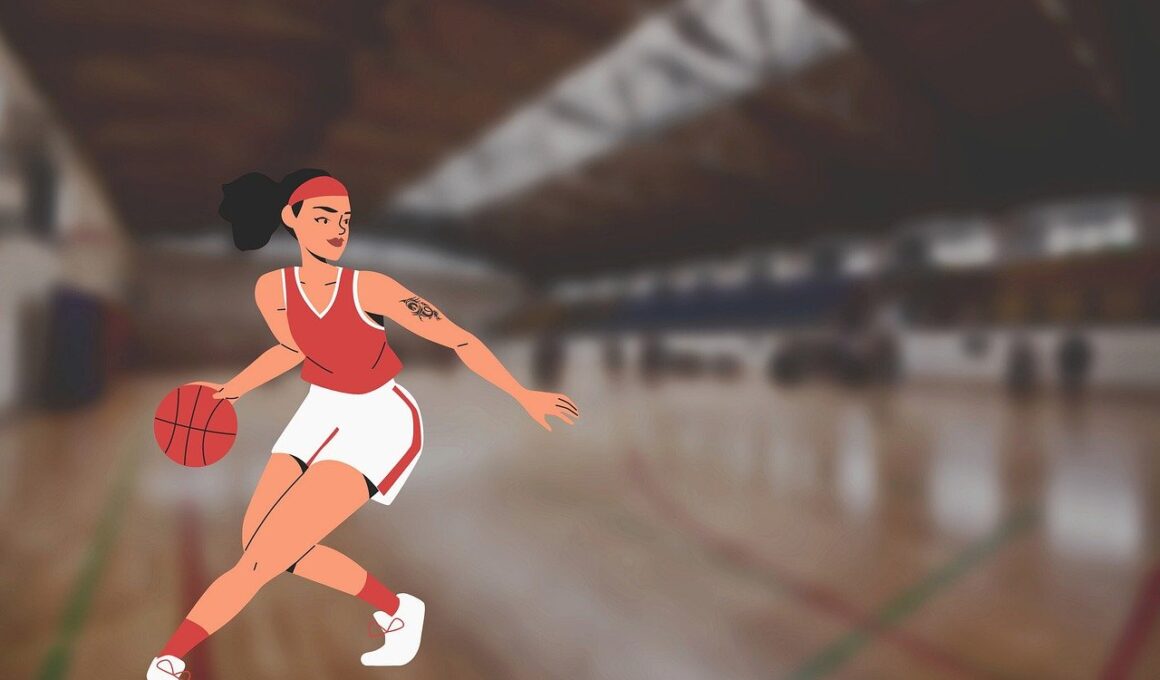Conditioning Programs Tailored for Basketball Athletes
Conditioning programs tailored for basketball athletes are essential for maximizing performance and endurance on the court. Coaches need to design specific training regimens that align with the demands of the game. Basketball requires a unique combination of endurance, agility, and explosive power. Therefore, understanding the physiological demands is crucial for effective training. A well-rounded conditioning program consists of various components focused on strength, speed, and anaerobic fitness. Coaches often implement exercises that mimic basketball movements to enhance muscle memory and efficiency. Agility drills, such as ladder drills and cone sprints, are vital to improve footwork. Additionally, plyometric exercises, like box jumps, enhance explosive speed and vertical leap. Customized cardiovascular workouts, incorporating interval training, prepare athletes for the game’s intense nature. Each session should include dynamic warm-ups to prevent injury and elevate performance. It’s vital to use a holistic approach, considering nutrition and recovery in tandem with workouts. Coaches should communicate with athletes about their conditioning needs, setting realistic goals and adjusting programs as necessary. Evaluating progress regularly helps ensure athletes remain competitive and healthy throughout the basketball season.
The implementation of a successful conditioning program relies heavily on understanding each athlete’s unique strengths and weaknesses. Coaches should conduct fitness assessments to pinpoint areas requiring improvement. These assessments can help determine the appropriate workouts tailored to each player. By monitoring power output, agility, and endurance levels, coaches can effectively track progress over time. Furthermore, establishing a baseline helps in designing achievable, personalized goals. This data also aids in creating a framework for evaluating program effectiveness throughout the season. Additionally, regular feedback from athletes can enhance understanding of training effectiveness and enjoyment. Coaches should emphasize the importance of cross-training to prevent monotony and injuries. Thus, incorporating different activities, such as swimming or cycling, not only supports overall fitness but also maintains motivation. Each athlete should work on strength training to develop core muscles essential for basketball. Periodization within the program is crucial, with phases focusing on hypertrophy, strength, power, and active recovery. This structured approach ensures athletes never plateau and consistently improve day by day. Ultimately, building trust and communication with athletes will lead to successful long-term conditioning outcomes.
Strength Training for Basketball Athletes
Strength training plays a pivotal role in the conditioning of basketball athletes, as it develops the foundational power necessary for skill execution. Coaches often use resistance training to help players increase their overall strength, aiding their ability to perform under load during games. Programs should focus on the major muscle groups, specifically the legs, core, and upper body. Effective exercises include squats, deadlifts, and bench presses, strategically designed to improve muscle coordination. Additionally, Olympic lifts can enhance explosiveness and promote functional strength. It’s paramount to focus on proper form to prevent injuries, especially when introducing heavier weights. Coaches should provide personal guidance on executing movements correctly. Another effective technique is the incorporation of bodyweight exercises, which build strength while improving mobility. Moreover, integrating resistance bands offers versatility in workout variations, enabling athletes to perform controlled movements that benefit their game performance. A balanced program includes both push and pull movements to prevent muscle imbalances. Strength training sessions must be scheduled 2-3 times a week, aligned with practice sessions and games to avoid overtraining. Continuous adaptation of the training plan ensures the progressive overload necessary for strength development.
Incorporating agility drills in a conditioning program for basketball athletes is crucial to optimize their on-court performance. These drills improve foot speed, coordination, and overall reaction time, allowing players to navigate the court efficiently. Coaches should include various agility exercises, such as shuttle runs, zig-zag drills, and lateral lunges, which mimic the unpredictable nature of a basketball game. These workouts should focus on quick changes of direction, which are fundamental during offensive and defensive plays. Challenge athletes with competitive elements, including timed trials or reactive drills, to enhance focus and mentoring relationships. Periodically re-evaluate agility performance, adjusting drills as necessary to maintain progress. Consistency in practice ensures that athletes develop muscle memory, making movements instinctive during real games. Incorporating plyometrics in conjunction with agility training maximizes explosive power. Exercises like jumping drills can help athletes generate the speed and elevation needed for rebounds and shots. Coaches should encourage athletes to maintain proper posture during these drills, emphasizing the importance of a strong core. Finally, routine stretching and mobility work facilitate flexibility and minimize injuries, reinforcing the need for a comprehensive approach to agility training.
Endurance Training in Basketball Conditioning
Endurance training is a fundamental component of conditioning programs designed for basketball athletes, enhancing their capacity to sustain high-intensity efforts. Given basketball’s fast pace, players require a blend of aerobic and anaerobic conditioning to perform optimally. Long-distance running enhances aerobic capacity, while high-intensity interval training (HIIT) permits anaerobic conditioning suitable for the sport’s demands. Coaches should strive to blend these two components by designing workouts that include both continuous runs and interval sprints. Integrating basketball-specific drills during these sessions ensures athletes become accustomed to the physical demands experienced during games. It’s advisable to vary running distances and intensities regularly for comprehensive conditioning. Another beneficial practice is incorporating circuit training, where athletes rotate through various exercises, including skipping rope and short sprints. These workouts build stamina while maintaining the interest of athletes. Additionally, hydration is a pivotal aspect of endurance training; coaches should educate athletes on proper fluid intake strategies for optimal performance. Finally, understanding individual athlete’s energy systems enables coaches to tailor sessions that specifically cater to enhancing endurance, thus leading to improved overall game performance.
A well-rounded basketball conditioning program must include adequate recovery strategies to sustain athlete performance levels effectively. Recovery is often underestimated in basketball training; however, it is essential for preventing burnout and injuries. Coaches should educate athletes about the significance of rest days and active recovery sessions. Techniques such as stretching, foam rolling, and massage therapy can enhance recovery. Implementing post-training recovery protocols, including nutrition-focused recovery drinks, aids in muscle repair and rehydration. Additionally, encouraging athletes to prioritize sleep is crucial, as this natural recovery process significantly impacts performance. Coaches should monitor fatigue levels and stress responses, adjusting training loads accordingly to foster recovery. Incorporating yoga or pilates into training can improve flexibility and core strength while aiding relaxation. Another essential recovery aspect lies in mental conditioning; practices such as mindfulness or visualization techniques can equip athletes to handle the psychological demands of the game. Ultimately, ensuring a balance between training workloads and recovery practices leads to athletes remaining persistent throughout the season, achieving peak performance when it matters most during competitions.
The Role of Nutrition in Athlete Conditioning
Nutrition is a key component of a basketball player’s conditioning program, impacting overall performance and recovery. It is crucial for athletes to understand the nutritional framework that supports their training requirements. Nutrient timing can significantly enhance energy levels and reduce fatigue. Coaches should guide athletes to consume a balanced diet with an emphasis on carbohydrates, protein, and healthy fats for optimal functioning. Pre-training meals should be rich in carbs for energy and include lean proteins for muscle support. Post-training nutrition is equally important, involving high-quality protein sources to rebuild muscles. Meal planning must also account for hydration, as sufficient fluid intake maintains performance levels during practices and games. Emphasizing the consumption of natural, whole foods boosts micronutrient intake, which many athletes overlook. Coaches can hold workshops to enhance understanding of nutrient choices, empowering athletes to make informed decisions. Finally, monitoring each player’s eating behaviors and preferences can lead to more tailored nutritional guidance. Integrating nutritional education into training builds a comprehensive conditioning program, ensuring athletes are equipped for peak performance. With the right nutrition, players will thrive during the season.
To create effective conditioning programs for basketball athletes, implementing innovative methods keeps athletes engaged and empowered. Coaches should explore various training styles to maximize motivation and performance. These methods can include gamification of workouts, creating friendly competition among teammates. Using technology, such as fitness apps, can assist in tracking performance and recovery, providing athletes with valuable feedback. Incorporating team bonding exercises, such as obstacle courses, can also enhance motivation while promoting camaraderie. Monitoring athlete progress and rewarding improvements fosters a positive training environment. Another interesting approach is blending traditional training with unconventional activities, like dance or martial arts, to develop agility and coordination. Furthermore, creative programming keeps sessions fresh while emphasizing the enjoyment of the exercise, crucial for lifestyle adherence. Challenges can be integrated within workouts, setting goals for athletes to achieve during practice. Coaches are encouraged to regularly collect feedback from athletes, ensuring their needs and interests align. An engaging conditioning program empowers athletes, enhances their motivation, and sets them up for success on the court, contributing to better performances overall in basketball competitions.





